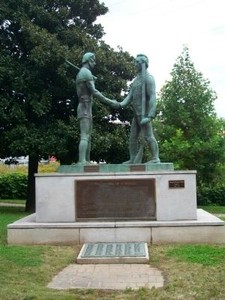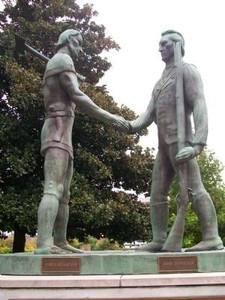Founding of Nashville Monument
Introduction
Text-to-speech Audio
Images
Founding of Nashville monument (image from the Historical Marker Database)

Statues of Robertson and Donelson (image from the Historical Marker Database)

Backstory and Context
Text-to-speech Audio
Colonel James Robertson (1742-1814) was born in Virginia, arriving in the Watuga Settlement (today's eastern Tennessee) in 1769. An early frontiersman into the area, he gained the mutual respect of many American Indians, allowing him, in 1779-1780, to lead the overland expedition of 226 men to French Lick (Nashville) at the request of Colonel Richard Henderson (1735-1785). Henderson, another Virginian, had purchased territory from the Kentucky River to the Cumberland from the Cherokee, and initially attempted a settlement at Boonesborough. The settlement title was lost to Virginia, however, and he subsequently commissioned Robertson to lead the Land Party, which built and defended Fort Nashborough while awaiting the spring arrival of settler families.
Colonel John Donelson (1718-1786) of Delaware served as a member of the Virginia House of Burgesses, a Lieutenant Colonel of Pittsylvania County in the Revolutionary War, vestryman of Camden Parish, and was, as a young man, an iron manufacturer, surveyor, and diplomat to American Indian tribes. Like Robertson, he arrived in the French Lick area in 1779-1780, but by boat along the Cumberland River, bringing families rather than lone frontiersmen across a 1,000-mile journey.
Robertson and Donelson met on Monday, April 24, 1780, and shook
hands in a gesture of cooperation toward the founding of the settlement which eventually
became Nashville. Donelson achieved a treaty with the Chickasaw near
Nashborough in 1783 before his death in Kentucky three years later. According
to the inscription on the Nashville statue depicting the historic handshake
between Robertson and Donelson, "This statue is intended to keep their
memory green and our love for them tender and profound. These men are the
trees; we are their fruit."
Sources
2. City-Data.com. "Nashville: History." Accessed May 8, 2017. http://www.city-data.com/us-cities/The-South/Nashville-History.html.
3. Walker, Kathy. "Founding of Nashville." Historical Marker Database. November 11, 2009. Accessed May 8, 2017. http://www.hmdb.org/Marker.asp?Marker=81453.
4. --- "Colonel James Robertson." Historical Marker Database. November 8, 2009. Accessed May 8, 2017. http://www.hmdb.org/Marker.asp?Marker=24240.
5. ---. "Colonel Richard Henderson." Historical
Marker Database. November 11, 2009. Accessed May 8, 2017. http://www.hmdb.org/Marker.asp?Marker=24373.
